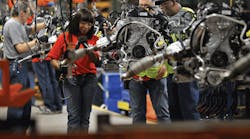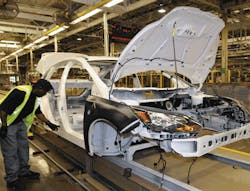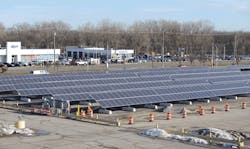If you want to know the state of the economy, look no further than Detroit and its automakers. After all, the economy is based on the flow of goods and services, and it's transportation that enables those flows. The more things move, the higher demand there is for the cars and trucks that move them.
What's more, manufacturers of the metals, glass and plastics that go into vehicles, as well as workers who build highways, upkeep roads and repair cars, all depend on the economic strength of the auto industry. The Alliance of Automobile Manufacturers estimates that every job the auto industry creates equals nine supplier or downstream jobs – that impact alone is pretty powerful.
The good news is that things are looking up for Detroit. U.S. auto sales are predicted to gain 10 percent for a third straight year. That figure might not mean much to those outside the industry or Wall Street, but to put it in perspective, such a streak has occurred only four times since the Great Depression.
Beyond serving as a barometer for the general economy, Detroit also represents the composition of it. The types of vehicles being made, the processes used to make them and the attributes people consider in their purchasing decisions – each provides insight into the general direction of manufacturing and consumer sentiment in our country.
The Blue Oval Goes Green
Today, we're seeing unprecedented shifts in engine technology and fuel economy, which are detailed in Ford's 2012 CSR report. Already, around one-third of Ford's vehicle lines offer a model with 40 miles per gallon or better.
With models like the Ford Fiesta and Ford Focus, the number of gasoline powered cars that can achieve more than 40 mpg on the highway has climbed to nine, compared to 2010 when there was only one such car. Add electrified vehicles to the equation, and that number more than doubles. We even have cars today that break the 100-mile threshold. The Ford Focus Electric, for instance, goes an EPA-certified 110 MPGe, an unimaginable number even a few years ago.
Certainly, reducing fossil fuel consumption represents a large part of the shift; however, there's more to it than the engine. Companies have grown to consider the entire lifecycle of their vehicles. Today, Ford runs a dedicated biomaterials program that researches and implements materials derived from post-consumer products and bio-based fibers and resins as alternatives to those that are petroleum-based. The end results of these efforts are evident in any Ford you buy today.
Seats and headrests now are filled with soy-based foam to offset petroleum use. Old blue jeans are used for carpet and insulation. Wheat straw and other plant-reinforced plastic are used for storage bins and door panels, reducing the company's oil consumption. Carpets and fabrics are made from recycled soda pop bottles. We're even looking at retired currency from the Federal Reserve as a potential base material for plastic components in interiors.Overall, about 85 percent of the materials used on Ford vehicles by weight are recyclable, and approximately 95 percent of all vehicles retired from use each year are processed for recycling. Other automakers have made significant progress as well. For an industry as large as the automotive industry/sector, compound changes can make a huge difference.
Reducing Facility Emissions
In addition to the materials that go into vehicles, it equally is important to note environmental advancements from a facilities perspective. Since 2000, Ford has been able to reduce its CO2 emissions from its global manufacturing facilities by 4.5 million metric tons, approximately 48 percent. The company reduced the amount of energy required to produce each vehicle by 22 percent over the last 6 years, and plans to reduce usage another 25 percent per vehicle by 2016.
Similarly, Ford reduced its global water use by 60 percent, or 10 billion gallons between 2000 and 2011 – the equivalent of how much water 100,000 average American residences use annually, based on figures from the U.S. Environmental Protection Agency. Building on this success, Ford plans to cut the amount of water used to make each vehicle 30 percent globally by 2015, compared with the amount of water used per vehicle in 2009. Meeting this goal would mean that the amount of water used to make a vehicle will have dropped from 9.8 cubic meters in 2000 to approximately 4 cubic meters in 2015.
Many advancements support these reduction figures. For instance, to reduce water use, Ford makes use of new technologies and manufacturing strategies that include biological water treatment systems and “dry-machining,” which minimizes the need for lubricants.
Additionally, through improved paint processes, the company is able to reduce volatile organic compound emissions by 10 percent and CO2 emissions by up to 40 percent compared to traditional paint systems. Ford also has developed ways to convert volatile paint compounds into fuel, reducing the amount of natural gas that would otherwise be used to destroy them. This fumes-to-fuel system can cut CO2 emissions by up to 80 percent compared to traditional abatement processes.
Furthermore, in 2010 and 2011, Ford enlisted 40 buildings in the Michigan area into a performance contract to upgrade to more efficient lighting, reducing energy use by more than 18.2 million kilowatt-hours – enough to power 1,648 U.S. homes for a year. The project also eliminated more than 11,000 metric tons of CO2 emissions. Based on these efforts and other publicly stated goals, Ford was honored with the EPA's Climate Leadership Award earlier this year.
Transformation Through Conservation
So, to put all this information back in terms of the economy, Detroit's recovery doesn't just represent the country's recovery. It also reflects a transformation toward jobs and services that revolve around the environment and the conservation of resources – as they relate to facilities management and manufacturing process, as well as consumer's pocketbooks. While a strong auto sector still means work for traditional suppliers, it also means green companies like Unifi that makes Repreve – the recycled plastic fabric used in Ford cars – are working at full capacity and hiring workers into the new, green economy.
It would be far more difficult toachieve these results and goals if they weren't in line with consumer demand. While companies like Ford are winning awards and praise for their commitment to the environment, it wasn't too long ago that a greener economy was a highly precarious bet. In 2007, the country purchased a record-high 350,000 electrified vehicles. That progress faltered, however, as the recession tightened its grip on purchasing ability and commerce across all sectors. For the 2 years between 2007 and 2009, sales of all vehicles plummeted, electrified ones included. In 2010, only 250,000 hybrid and electrified vehicles were sold.
That Was Then
If Detroit is any indication of broader-scale growth, the worst (hopefully) is behind us. In March, consumers bought a record 52,000 gas-electric hybrids and all-electric cars, up from 34,000 during the same month last year. These positive numbers support Ford's market projections and goals for 10 to 25 percent of its global sales to be derived from electrified vehicles (hybrids, plug-in hybrids and full electric) by 2020. To support these figures, Ford employs a team of more than 1,000 engineers who work on hybrid and electrification programs, including the Focus, Fusion and CMAX models.
In fact, these programs are growing so rapidly that the company recently announced that its 285,000-square-foot Advanced Engineering Center in Dearborn, Mich., would be converted to electrified vehicle development. With the company planning to add more than 12,000 hourly and salaried jobs by 2015 in the United States, the space is needed. Also needed is the support of those extra workers. Ford announced earlier this year that it plans to triple U.S. production capacity of its hybrid, plug-in hybrid and electric vehicles compared to 2011 numbers.
Ford isn't the only manufacturer that's making major investments in electric automobile technology. Many are, and the manufacturing of these vehicles will provide employment opportunities for workers in the auto sector and in businesses ancillary to it.
On the heels of the recession, we're still too close to fully appreciate the impact the past few years have had on our country and the direction in which it is headed. But one thing is certain – we've pulled out of a difficult time with more of a focus on the ways and means through which we create and consume.
On a large scale, we're seeing companies instituting sweeping environmental initiatives, and consumers, as a whole, increasingly favoring products with environmental attributes. On a micro scale, drivers of ultra-efficient cars have a front-row seat to the changes taking place. Hopefully, years from now when we look back to this time, we'll view what we're beginning to see today as the beginnings of a butterfly effect that reflects a long-term commitment to sustainability as both consumers and manufacturers.
John Viera is global director of sustainability and vehicle environmental matters at Ford Motor Co., a position he has held since January 2007. In this role, Viera is responsible for developing global sustainable business plans and policies, interfacing with global regulatory bodies, reporting externally on the company's environmental and social performance and leading the company's engagement and partnerships with non-government organizations (NGOs) and other key stakeholders. Viera has held several positions within Ford Motor Co. during his 27-year tenure at the company.


